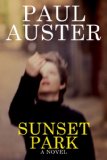Some writers end up being put in a box because their style and subjects seem to forever place them in a particular category or genre. Paul Auster usually ends up in the box labeled “Postmodernist.” Yet the more Auster I read, the more convinced I am that he ends up with that label because his writing defies easily placing him in convenient boxes. His latest novel, Sunset Park, adds to my belief.
 Some of the labels most often placed on Auster’s work aren’t present here. There’s no real metafictional element. In fact, depending on how you define postmodernism (if it can be defined), Sunset Park may not fit in the box. Yet the book still relies on literary devices to explore themes common to his writing and, perhaps, some new ones. A group of damaged characters trying to survive the effects of this century’s economic downturn become a method to explore the search for identity, existential angst and the concepts of home and family.
Some of the labels most often placed on Auster’s work aren’t present here. There’s no real metafictional element. In fact, depending on how you define postmodernism (if it can be defined), Sunset Park may not fit in the box. Yet the book still relies on literary devices to explore themes common to his writing and, perhaps, some new ones. A group of damaged characters trying to survive the effects of this century’s economic downturn become a method to explore the search for identity, existential angst and the concepts of home and family.
The novel is built around Miles Heller, a 28-year-old living in self-imposed exile in Florida when the book opens. Miles has not spoken with his family since he dropped out of college seven years ago. He still struggles with what led to him leaving, thoughts of guilt over his role in the accidental death of his step-brother when he was a teenager and the impact of that death on himself, his father and stepmother. After dropping out of college, he becomes a hermit of sorts, moving from place to place and holding odd jobs. His current one is “trashing out” foreclosed homes, cleaning up after and removing all the possessions left behind by the former owners. Miles falls in love with a teenage girl but doesn’t even tell her about his father, who runs a small publishing house in New York City, or his mother, who left shortly after he was born and is now a famous actress.
Once events force Miles to return to New York City, he moves in with three other twenty-somethings squatting in an abandoned house in a Brooklyn neighborhood called Sunset Park. Here, Auster shifts the narration in turn to each of the them, and Miles, as they relate their past and the present. Bing Nathan, the self-appointed leader, was a high school friend of Miles who plays in a jazz group on weekends and runs a shop called The Hospital for Broken Things, where he repairs old items like manual typewriters and rotary telephones. There’s Alice Bergstrom, a grad student writing her dissertation on relations between men and women from1945 through 1947 largely through the prism of the 1946 film The Best Years of Our Lives. Finally, there’s Ellen Brice, who has struggled psychologically since a mistake while in college and seems to be finding an outlet creating erotic drawings. Their problems and aberrations — and a variety of sexual undertones — don’t require a great leap to see the house also may well be another hospital for broken things.
As Bing encourages Miles to renew contact with his parents, something Miles wants to do, Auster again changes the perspective. Miles’ father becomes the narrator and, again, we may well be encountering a broken thing. In addition to the years spent worrying about Miles and understanding generally why he left, Heller pere is confronted with a damaged marriage and economic threats to his publishing house. As a round-robin narration brings the book to a couple climaxes, we also hear from Miles’ mother. Although she seems to have thrived more than any other character, she is perhaps the least interesting. While she struggles with the impact her leaving may have had on Miles, her struggle is primarily dealing with returning to the Broadway stage after years on the big and small screen.
The use of multiple narrators and their different perspectives and stories is not Auster’s only interesting approach. While the four twenty somethings are plainly the main vehicle of telling a story about recent American life, various thoughts and concepts are explored through devices that aren’t as focused on the present. While some readers might find the analysis and discussion of The Best Years of Our Lives overdone, it is not often a six decade old movie becomes a mechanism by which characters contemplate contemporary disquietude. Similarly, Auster again invokes his love of baseball as historical items and trivia, some dating back decades, factor in as both Hellers assess their family and personal relationships.
Yet, for me, the characters, the story and the themes are undermined by another common element of Auster’s writing, his resistance to closure. While I don’t always insist on resolution, Sunset Park rather abruptly ends as a main character’s thoughts run away over the consequences of a conflict every reader will know is coming.the book’s ending. Perhaps this is simply Auster allowing a particular character’s existential angst, an issue difficult to resolve in even the best circumstances, to emerge in full force. Yet from my standpoint not only do readers deserve better, so do characters whose quirks and flaws give them authenticity.
…in the end books are not luxuries so much as necessities, and reading is an addiction he has no wish to be cured of.
Paul Auster, Sunset Park








The movie The Best Years Of Our Lives is worth any amount of discussion…especially in light of our current wars.